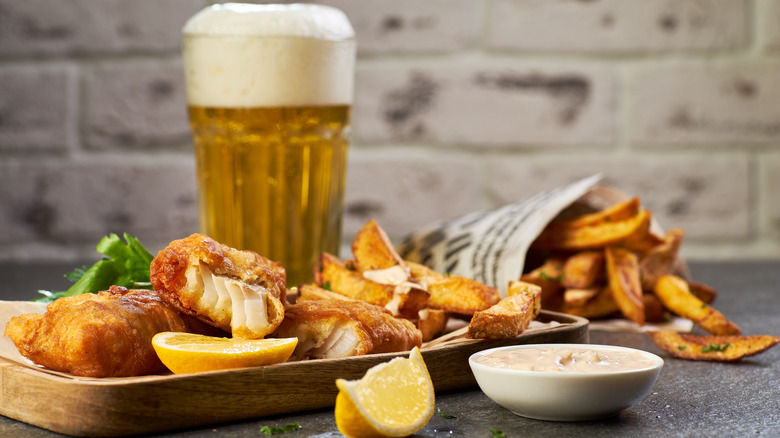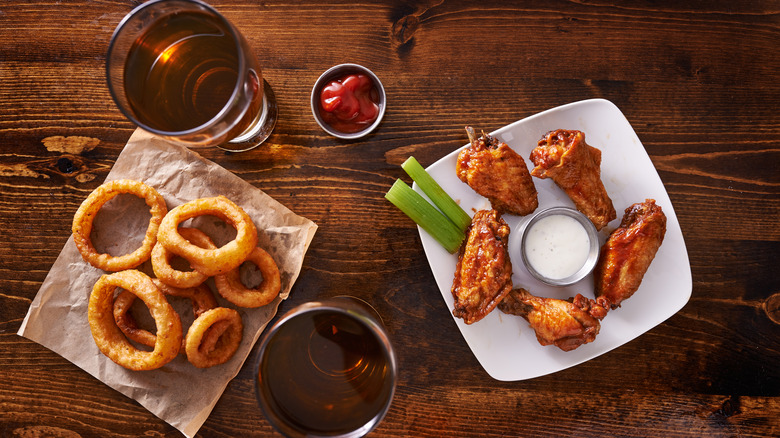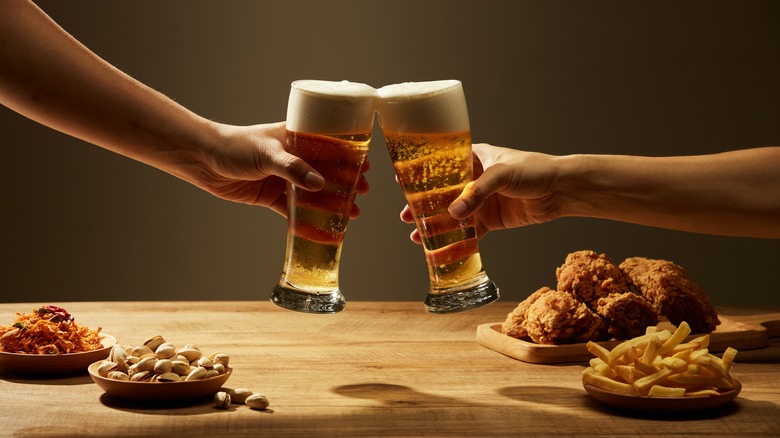Why Pale Ale Is The Best Type Of Beer To Pair With Fried Food
There are times when pairing drinks with food calls for a delicate wine with lots of subtle floral, herbal, and mineral notes — and there are times when you just want a big, frothy beer to complement your dinner. Beer can pair well with just about anything, but fried food in particular will have many of us craving a cold one.
Optimally, you want your beer to correspond to the flavors of the food while matching or balancing its textures and weight. According to Jessie Massie, Taproom Executive Chef at Sierra Nevada Brewing Co., when you're eating fried food, the best choice of beer is a pale ale.
"An all-around versatile choice is a classic pub-style beer like a pale ale," Massie told the Daily Meal. "A good English-style pale ale or American pale ale [...] can both cut through rich fatty flavors to cleanse the palate and also complement fry batter spices with approachable hoppy aromas."
Pale ales are medium-bodied, golden or amber-colored beers that, like their cousin, the IPA, include a bouquet of varied flavors and aromas, thanks to the high hop content. They tend to be a little bitter, but not exceedingly so, with bready, toasty notes and fairly strong carbonation. Pale ales manage to straddle the line of being approachable and versatile without being a shrinking violet when it comes to flavor, which is what makes them so good with food — especially your favorite deep-fried dishes.
Beer helps cut through the fat
Pairing food and drink is an art, not a science, with many different directions one can take. The factors to pay attention to are, of course, the flavors of the food, as well as the mouthfeel and general eating experience. Fried foods like chicken wings or French fries are saturated with oil, which can dominate the palate and make it hard to sense more delicate flavors. When choosing a beer, you'll want one that has strong enough flavors to stand up to heavy food, and a healthy amount of carbonation to break up the residual fat left on your palate.
American-style pale ales (also known as APAs) tend to be more carbonated than English pale ales (also known as ESBs, or extra special bitters), so if you're eating something really greasy, you may want to go American to thoroughly cleanse your palate. In either case, the beer's flavor won't get lost in the richness of the food, and the carbonation will be extra refreshing between bites.
A little bitterness complements fried foods
Massie also advises diners to pay attention to the IBU of a beer, which stands for International Bitterness Units and, as you can probably guess, measures how bitter a beer is. Pale ales typically have an IBU in the range of 30 to 50 (with a score of 120 indicating maximum bitterness), and Massie advises diners to lean toward the lower end of this range.
"Bitterness isn't all bad, but not all dishes will benefit from a bitter beer," Massie said. "Generally with fried foods, like classic pub foods, I usually recommend going middle-of-the-road and choosing a beer somewhere in the range of 25 to 45 IBU." Most breweries don't print the IBUs on bottle labels, so you might want to do a little research before hitting the store.
The actual flavor notes of both styles of pale ales can vary widely, but English pale ales tend to have a little bit more malty sweetness alongside the hoppy bitterness, offering notes of caramel or toffee. American pale ales typically offer more hops and are known for their more bitter flavor profiles. In fact, the company Massie works for, Sierra Nevada Brewing Co., is generally recognized as having invented this style of beer through its incorporation of Cascade hops, which offers a grapefruit-like taste and aroma. American-style pale ales will be predictably easier to find in the U.S. than other kinds, especially if you don't have access to a solid bottle shop.


